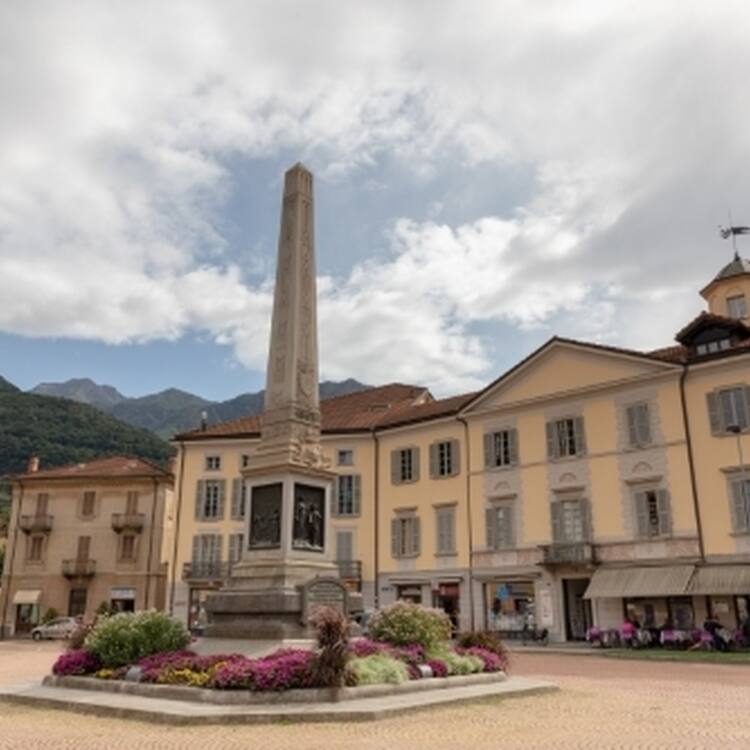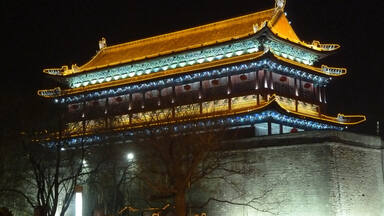Three Castles, Defensive Wall and Ramparts of the Market-Town of Bellinzona
Three Castles, Defensive Wall and Ramparts of the Market-Town of Bellinzona
The Bellinzona site consists of a group of fortifications grouped around the castle of Castelgrande, which stands on a rocky peak looking out over the entire Ticino valley. Running from the castle, a series of fortified walls protect the ancient town and block the passage through the valley. A second castle (Montebello) forms an integral part of the fortifications, while a third but separate castle (Sasso Corbaro) was built on an isolated rocky promontory south-east of the other fortifications.
Description is available under license CC-BY-SA IGO 3.0
Trois châteaux, muraille et remparts du bourg de Bellinzone
Le site de Bellinzone est composé d'un ensemble de fortifications centré sur le château de Castelgrande qui se dresse au sommet d'un rocher surplombant la vallée du Tessin. Depuis ce château, une série de fortifications protège l'ancienne ville et barre la vallée du Tessin. Le deuxième château (Montebello) est intégré au dispositif fortifié ; un troisième château isolé (Sasso Corbaro) a été construit sur un promontoire au sud-est de l'ensemble.
Description is available under license CC-BY-SA IGO 3.0
ثلاثة قصور وسور وأسوار مدينة بيلينزون
يتألف موقع بيلينزون من مجموعة حصون محيطة بقصر كاستل غراندي المتربع على قمة صخرة مطلة على وادي تيسين. وتقوم سلسلة من الحصون انطلاقاً من القصر بحماية المدينة القديمة وبسد وادي تيسين. ويندمج القصر الثاني (مونتيبيلو) في المجموعة المحصّنة بينما يرتفع القصر الثالث المنعزل (ساسو كوربارو) على صخرة شاهقة جنوب شرق المجموعة.
source: UNESCO/CPE
Description is available under license CC-BY-SA IGO 3.0
贝林佐纳三座要塞及防卫墙和集镇
贝林佐纳遗址由堡垒群组成的,这些堡垒围绕着卡斯特尔格朗德城堡,该城堡坐落在一座石峰上,俯瞰整个提契诺谷。一排排防御墙从城堡中延伸出来,保护了古镇并阻隔了穿越山谷的通道。第二座城堡(蒙特贝罗城堡)与堡垒连为一体,而第三座(萨索·科尔巴洛城堡)则是一座独立的城堡,矗立在其他堡垒东南方向一块孤立的岩石海角上。
source: UNESCO/CPE
Description is available under license CC-BY-SA IGO 3.0
Три замка, крепостные стены и валы торгового города Беллинцона
Архитектурный комплекс Беллинцоны состоит из группы укреплений, сосредоточенных вокруг замка Кастельгранде, который, будучи расположен на скалистом возвышении, контролировал всю долину реки Тичино. Отходящие от замка крепостные стены защищали Старый город и перекрывали проход по долине. Второй замок – Монтебелло - составлял часть оборонительной системы, а третий, стоящий отдельно, замок Сассо-Корбаро был построен на изолированной скалистой возвышенности к юго-востоку от остальных укреплений.
source: UNESCO/CPE
Description is available under license CC-BY-SA IGO 3.0
Tres castillos, murallas y defensas del burgo de Bellinzona
El sitio de Bellinzona comprende un conjunto de fortificaciones construidas en torno al castillo de Castelgrande, erigido en lo alto de una cima rocosa que domina el valle del Tesino. De este primer castillo parte una línea de murallas que protege la ciudad vieja y cierra el paso del valle. Un segundo castillo, el de Montebello, forma parte de este mismo dispositivo de defensa. El tercer castillo es el de Sasso Corbaro, que se yergue aislado en lo alto de un promontorio rocoso situado al sureste del burgo fortificado.
source: UNESCO/CPE
Description is available under license CC-BY-SA IGO 3.0
ベリンツォーナ旧市街にある3つの城、要塞及び城壁
source: NFUAJ
Drie kastelen, verdedigingsmuur en versterkingen van de marktstad Bellinzona
Source: unesco.nl
Outstanding Universal Value
Brief synthesis
The fortified ensemble of Bellinzona located in the canton of Ticino in the Italian-speaking part of Switzerland, south of the Alps, is the only visible example in the entire Alpine Arc of medieval military architecture comprising several castles, linked by a wall that once closed off the whole Ticino Valley, and the ramparts which surrounded the town for the protection of the civilian population.
Bellinzona thus constitutes an exceptional case among the greatest fortifications of the 15th century, both by the dimension of its architecture, influenced by the site and topography, and by the excellent state of conservation of the ensemble.
The origin of Bellinzona is linked to the strategic situation of the site that controls, by the Ticino Valley access to the principal Alpine pass constituting the passage into the Milanese, in fact, the whole of north Italy to the regions located farther north to the Danube and beyond.
The ensemble comprises three castles and a network of fortifications with towers and defence works that command the Ticino Valley and dominate the town centre.
Criterion (iv): The fortified ensemble of Bellinzona is an outstanding example of the late medieval defensive structure guarding a key strategic Alpine pass.
Integrity
The fortifications of Bellinzona have conserved intact their typical aspect of the late Middle Ages. Putting aside substantial losses to the wall and the ramparts of the town, the property comprises the ensemble of the conserved defensive works (castles, wall and ramparts) and thus retains all the requisite elements to express its Outstanding Universal Value.
Authenticity
The authenticity of the property is clearly witnessed by the numerous documents concerning its evolution. However, it has been affected to a certain degree by reconstructions, in particular the crowning of the walls, while the majority of the built substance is original and bears witness to developments over time. The use of the site is today cultural (museum, visits to the castles); the fortifications however represent a strong signification for the urban landscape and cultural environment.
Protection and management requirements
The property has legal protection at all State levels. The three castles, the Murata and the buffer zone are protected by the Degree of 18 May 1926 and amended on 23 October 1962 by the Council of State of the Canton of Ticino: all the fortifications are shown in the land development plan for the territory of the Bellinzona Commune as monuments of cantonal and national interest and thus benefitting from all the instruments of protection provided in both federal and cantonal legislation in force, avoiding any risk of abuse.
A Convention concerning the management of the Bellinzona castles, signed by the Council of State of the Canton of Ticino, the town of Bellinzona and the Bellinzona Tourism Board, grants the Tourism Board the responsibility for the management of the castles, according to a coordinated concept of use that aims to valorise the heritage monuments from a cultural and a tourism perspective.
The mandate of the Tourism Board is threefold in nature and comprises: a) the valorisation of the monumental complex through adequate cultural and touristic promotion; b) the administration of the property and areas in function of their dual character of public and World Heritage property; c) the maintenance of the buildings and movable heritage based on the indications of the cantonal services.
The Canton conserves the ownership of the property with its important maintenance costs and allocates an annual lump sum to the management, whilst conserving the right of use of the castles. The Canton is responsible for the conservation and the surveillance of the monumental complex as a protected cultural property.
The town of Bellinzona provides services of different nature and allocates financial contributions towards management costs (water, electricity, waste water and rubbish).
To control and coordinate all the activities linked to the management and exploitation of the castles, a permanent commission was established, comprising six members designated by the signatories of the Convention.
In particular, this commission ensures liaison with the different institutional officers, is responsible for controlling the provisions of the Convention (with the possibility of calling upon political parties and signalling all serious violations), the preparation of regulations for the use of the castles, the elaboration of requisite guidelines to ensure an efficient cultural promotion and the supervision of the calendar of events. It also has the task of controlling and planning the necessary investments for the maintenance of the castles involving all the actors of the Convention.
Improvements for visitors, notably those made at the Castel Grande, a site of superior architectural quality, must maintain the delicate balance between authenticity of the site and an excessive concern for its presentation.

